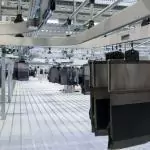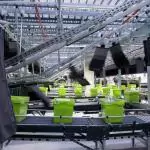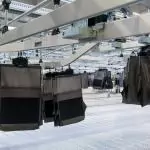The Pouch sorter / Bag sorter belongs to the category of logistic sorting and distribution systems. A (hanging) bag sorter system makes it possible to transport hanging and flat packed goods fully automatically on the same line – even classic cardboard packed goods are not uncommon. Transport breaks, as with conventional systems, for example by transfer to the forklift, are usually avoided.
A bag sorter is mainly used in the areas of returns and picking(mainly in the fashion industry). Application. However, there are also bag sorter systems that are also used as storage or buffer systems (see Buffer functions in practice). A bag sorter’s Warehouse Management System (WMS) or material flow control system routes the bags and goods fully automatically directly to the packing station – classic order picking is therefore no longer necessary for bagged goods. The article rotates in the system until it is released by the WMS for processing – provided that the goods can tolerate storage or transport in non dimensionally stable conveyor elements. Normally, lying and hanging goods should not remain in the bag for more than three days. On the one hand, it should be noted that a T-shirt or shirt, for example, can be crumpled up and create a stowage length of up to seven centimetres at the bottom of the bag. On the other hand, bag sorter systems are designed for fast-moving goods, which should be considered in warehouse planning. Long-term storage in bag sorters is therefore not an option.
Buffer function in practice
Especially the high scalability of the so-called dynamic buffer* should be mentioned. Here, frequently requested articles as well as collected returned articles are kept in the bags and do not have to be picked manually. Each bag, equipped with an RFID chip or barcode, is combined with exactly one physical item (see the linked video). When processing sales orders, articles from the dynamic buffer are accessed first. If it does not contain parts of the sales order, these are manually sorted into additional bags, if appropriate. Subsequently, all bags are transported fully automatically to the packing station and ideally, the sorter also combines them directly and passes them on to dispatch.
Bag sorter: Saving warehouse space and process time
The advantage of a bag sorter is its economic use of space, due to the vertical pocket arrangement. In contrast to other systems, it is possible to store goods much more densely. In addition, a bag sorter is often installed directly under the ceiling of a distribution centre, thus saving or freeing up valuable floor space. Also decisive: the automatic individual access to each transported piece.
Suppliers often promise a placement of up to 25 bags per meter. However, this figure is dependent on the assortment stored and the season, especially in the fashion industry. It should also be noted that, as a rule, only one article can be transported per bag for process-related reasons.
Important: The number of packing stations depends on the individual processes and process times at each station. In figures; when 7,500 bags are used, an average of about ten loading places and 30 packing places are expected in typical applications. Depending on the manufacturer, current bag sorter systems can typically handle around 10,000 cycles per hour, making it easier and faster to process short-term marketing campaigns and seasonal peaks. This results in a usable operating capacity of the mentioned 7,500 bags per hour; partly because not every cycle speed can be used – (see the video). Of course, the time saved depends on the individual processes that take place after the quality inspection (returns processing) at goods receipt or at returns receipt.
Example: Conventional work steps for the restocking of returns
- Quality control
- Pre-sorting for each picking zone
- Transport to the picking zone
- Transport to the storage place
- Storage
- Matching the storage location (storage bin management)
Work steps for the bag sorter
- Quality control
- Pre-sorting (decision ‘baggable’ – yes or no)
- Transport to the loading station
- Storage / Bag
Important: The bag sorter initially eliminates the conventional picking processes. The employee only decides ‘baggable – yes or no’ after the quality check. If the goods are not baggable, they are transported and handled via the conventional conveyor system. Goods not in stock, however, can be manually picked from the warehouse and fed into the bag sorter. At the end of a season, the buffer should also be cleared of the seasonal assortment. This usually happens automatically. These goods must then also be picked from the bags and returned to the warehouse via the classic storage process.
Conclusion bag sorter
A bag sorter is suitable for goods that only remain in the warehouse for a short time. One reason why a bag sorter can also act as a buffer. Because based on the buffer function, only part of the returned goods has to be sorted back into the warehouse – fast-moving items can be requested directly from the buffer.
For example, where there is a high volume of returns (multi-channel and omnichannel– generally e-commerce strategies), it is usually worthwhile to use a combination of bag sorters and conventional conveyor and storage techniques.
For more information about material flow, see also the articles Material Flow Simulation and Transport Management.
Teaser image: Press image – Marcus Vetter / Gigaton GmbH
Image galerie bag sorter: courtesy of arvato Bertelsmann SCM Solutions
* Case Study – Logistik-Wachstum in der Tasche, Arvato Bertelsmann
Also available in Deutsch (German)


